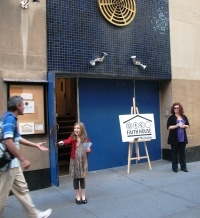c. 2008 Religion News Service
NEW YORK _ A Christian, a Jew, a Muslim, a Buddhist and an atheist walk into a prayer meeting.
Any number of punch lines could follow, but the members of Faith House Manhattan have serious business in mind: creating a spiritual community for people from any _ or no _ religious tradition.
The fledgling group of about three dozen regular participants is overseen by Samir Selmanovic, a Seventh-day Adventist pastor for whom interfaith ideals come naturally: He describes himself as an “atheist Muslim” who converted to Christianity during his military service in the former Yugoslavia.
“I wanted to build a church where Christians are not in charge,” he explained after a Saturday afternoon gathering of Jewish prayers and Beatles music. “We wanted to include all the people who have a right to belong and be partners in the discussion, not as outsiders that need to be converted, but as insiders that we need to be interdependent with.”
Similar interfaith centers are on the rise across the country, according to the Pluralism Project at Harvard University, which reported a surge in the years after the 9/11 terrorist attacks. There are now more than 550 such groups in America, with the largest numbers in New York, California, Massachusetts and Illinois.
In addition to easing religious tensions and encouraging joint philanthropic and community activities, Pluralism Project spokeswoman Kathryn Lohre said, these groups create new roles for women, which has been the case for Faith House.
“Interfaith organizations provide opportunities for women’s leadership in a way that oftentimes the religious traditions themselves do not, simply because those positions do not need to be sanctioned by any religious head or body,” she explained.
At Faith House, all three “co-leaders” (of the Jewish, Christian and Muslim programs) are women. That’s a coincidence, Selmanovic said, but one he is happy about, even if it prompts traditionalists to underestimate their efforts for the time being.
At a recent gathering, co-leader Jill Minkoff, a rabbinical student at the Academy for Jewish Religion, recited the Kaddish mourner’s prayer for her father, explaining its meaning to the Christians, Muslims and other non-Jews in attendance.
For regulars like Mujadid Shah, a Muslim, the desire to learn more about other faiths motivates them to attend Faith House meetings, in addition to their own worship services.
“This is knowledge that I might not learn otherwise,” Shah said. “I pursue educating myself on a spiritual path.”
The group’s efforts are not limited to increasing understanding between religions; a recent lecture focused on “The Blessing of Atheism.” As a spiritual exercise, Selmanovic asked participants to write down their impressions of God onto slips of paper. At the end of the 90-minute meeting, he lit candles for them to burn their scribbles, dividing the ashes up into small plastic bags that they could take home with them.
“When you are sure about anything at all, you can put your hand in your pocket and touch it,” Selmanovic explained, as words like “all-knowing spirit” and “billions of years ago” crumpled and turned to ash beneath their fingertips.
Zorica Kuburic, a Serbian religion professor and coauthor of “Religion and Pluralism in Education,” thanked the pastor heartily as she took one of the last bags off the table. The gathering, which she had dropped in on during a business trip to New York, seemed like the next chapter in the budding interfaith movements she has studied in the Balkans and other parts of the world, she said.
“This is very good, because you can have stronger faith when you exchange ideas with people,” she said. “We try to understand each other better.”
With the noticeable exception of Selmanovic’s lively daughters, ages 10 and 13, most Faith House participants are between 30 and 50. About half come from Protestant traditions; about one-third do not attend other services during the week.
At the end of the gatherings, the group shares a table piled with cheese, fruit and various desserts, continuing the discussions of the week’s theme or catching up on current events.
The absence of a collection plate or donation box is conspicuous, given the generous spread and the $1,200 cost of renting space in a former synagogue for the Saturday meeting. So far, the group’s expenses have been paid by private donations; Selmanovic said he is working with a grant writer to solicit more funds.
Faith House’s e-mail newsletter has hundreds of subscribers, and he hopes word-of-mouth will bring about more attendance and event sponsors. As the group grows, Selmanovic believes it will play a key role in bringing New York City’s diverse religious communities closer together.
“We have to see that we are sojourners instead of competitors,” he said.
KRE/LF END NEROULIAS
825 words
A photo of members passing out flyers for Faith House Manhattan is available via https://religionnews.com.





